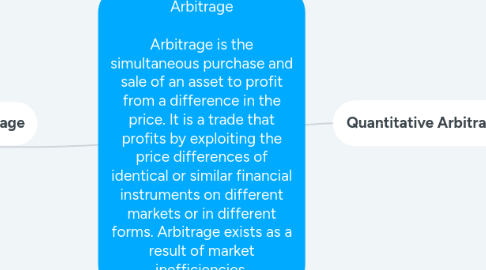
1. Financial Arbitrage
1.1. Cash & Carry
1.1.1. A cash-and-carry trade is a trading strategy in which an investor holds a long position in a security or commodity while simultaneously selling it – specifically, by holding a short position in a futures contract on the same security or commodity. In a cash-and-carry trade, which is also known as "basis trading"
1.2. Put-Call Parity
1.2.1. Put-call parity is a principle that defines the relationship between the price of European put options and European call options of the same class, that is, with the same underlying asset, strike price and expiration date. Put-call parity states that simultaneously holding a short European put and long European call of the same class will deliver the same return as holding one forward contract on the same underlying asset, with the same expiration, and a forward price equal to the option's strike price. If the prices of the put and call options diverge so that this relationship does not hold, an arbitrage opportunity exists, meaning that sophisticated traders can theoretically earn a risk-free profit. Such opportunities are uncommon and short-lived in liquid markets.
2. Quantitative Arbitrage
2.1. Volatility
2.1.1. Volatility Arbitrage
2.1.1.1. A volatility arbitrage strategy can be implemented through a delta-neutral portfolio consisting of an option and its underlying asset. For example, if a trader thought a stock option was underpriced because implied volatility was too low, she may open a long call option combined with a short position in the underlying stock to profit from that forecast. If the price of the stock doesn't move, and the trader is correct about implied volatility rising, then the price of the option will rise.
2.1.2. Volatility Skew
2.1.2.1. The volatility skew is the difference in implied volatility (IV) between out-of-the-money options, at-the-money options and in-the-money options. Volatility skew, which is affected by sentiment and the supply and demand relationship, provides information on whether fund managers prefer to write calls or puts. It is also known as a "vertical skew."
2.1.3. Dispersion Trading
2.1.3.1. The dispersion trading uses known fact that difference between implied and realized volatility is greater between index options than between individual stock option. Investor therefore could sell options on index and buy individual stocks options. Dispersion trading is a sort of correlation trading as trades are usually profitable in a time when the individual stocks are not strongly correlated and losses money during stress periods when correlation rises.
2.2. Options Strategies
2.2.1. Option strategies are the simultaneous, and often mixed, buying or selling of one or more options that differ in one or more of the options' variables.
2.2.1.1. Bull and bear spreads - If a spread is designed to profit from a rise in the price of the underlying security, it is a bull spread. A bear spread is a spread where favorable outcome is obtained when the price of the underlying security goes down Butterfly - buy ITM (in the money) and OTM (out of the money) call, sell two at the money calls, or vice versa. Straddle - holding a position in both a call and put with the same strike price and expiration. Collar - buy the underlying and then simultaneous buying of a put option below current price (floor) and selling a call option above the current price.
2.2.1.2. Calendar Spread
2.2.1.2.1. Since the goal is to profit from time and volatility, the strike price should be as near as possible to the underlying asset's price. The trade takes advantage of how near- and long-dated options act when time and volatility change. An increase in implied volatility, all other things held the same, would have a positive impact on this strategy because longer-term options are more sensitive to changes in volatility (higher vega). The caveat is that the two options can and probably will trade at different implied volatilities. The passage of time, all other things held the same, would have a positive impact on this strategy in the beginning of the trade until the short-term option expires. After that, the strategy is only a long call whose value erodes as time elapses. In general, an option's rate of time decay (theta) increases as its expiration draws nearer.
2.3. Pairs Trading
2.3.1. The strategy’s profit is derived from the difference in price change between the two instruments, rather than from the direction each moves. Therefore, a profit can be realized if the long position goes up more than the short, or the short position goes down more than the long (in a perfect situation, the long position rises and the short position falls, but that’s not a requirement for making a profit). It’s possible for pairs traders to profit during a variety of market conditions, including periods when the market goes up, down or sideways – and during periods of either low or high volatility.

